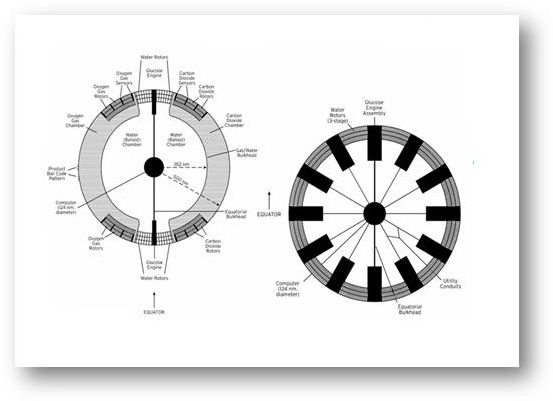The luxury six-hour roundtrip flight will include plush reclining seats, anti-glare windows for photography, and livestream-capable WiFi.



While chlorine and ultraviolet light are the standard means of disinfecting water, ozone is equally effective in killing germs. To date, ozone has only been used as an oxidation agent for treating water in large plants. Now, however, a project consortium from Schleswig-Holstein is developing a miniaturized ozone generator for use in smaller applications such as water dispensers or small domestic appliances. The Fraunhofer Institute for Silicon Technology ISIT has provided the sensor chip and electrode substrates for the electrolysis cell.
Compared to conventional means of disinfection such as chlorine or ultraviolet, ozone dissolved in water has a number of advantages: it is environmentally friendly, remains active beyond its immediate place of origin, has only a short retention time in water and is subsequently tasteless. Due to its high oxidation potential, ozone is very effective at combating germs. It breaks down the cell membrane of common pathogens. In Germany, ozone is chiefly used to disinfect swimming pools and drinking water and to purify wastewater. Yet it is rarely used to disinfect water in domestic appliances such as ice machines and beverage dispensers or in other fixtures such as shower-toilets. MIKROOZON, a project funded by the State of Schleswig-Holstein and the EU, aims to change this.
😃
As COVID-19 continues to ravage global populations, the world is singularly focused on finding ways to battle the novel coronavirus. That includes the UC Santa Barbara’s Solid State Lighting & Energy Electronics Center (SSLEEC) and member companies. Researchers there are developing ultraviolet LEDs that have the ability to decontaminate surfaces — and potentially air and water — that have come in contact with the SARS-CoV-2 virus.
“One major application is in medical situations — the disinfection of personal protective equipment, surfaces, floors, within the HVAC systems, et cetera,” said materials doctoral researcher Christian Zollner, whose work centers on advancing deep ultraviolet light LED technology for sanitation and purification purposes. He added that a small market already exists for UV-C disinfection products in medical contexts.
Indeed, much attention of late has turned to the power of ultraviolet light to inactivate the novel coronavirus. As a technology, ultraviolet light disinfection has been around for a while. And while practical, large-scale efficacy against the spread of SARS-CoV-2 has yet to be shown. UV light shows a lot of promise: SSLEEC member company Seoul Semiconductor in early April reported a “99.9% sterilization of coronavirus (COVID-19) in 30 seconds” with their UV LED products. Their technology currently is being adopted for automotive use, in UV LED lamps that sterilize the interior of unoccupied vehicles.


The U.S. is facing an unprecedented shortage of obstetricians and gynecologists (OB/GYNs). According to the American College of Obstetricians and Gynecologists, around half of the nation’s counties don’t have access to even a single OB/GYN, which means more than 10 million women are in need of OB/GYNs for primary care. Alarmingly, there are now 8000 fewer women’s health specialists than needed, and that number is predicted rise to 22000 by mid-century.
As the nation’s largest group of Maternal-Fetal Medicine (MFM) and OB/GYN Hospitalist providers, Obstetrix Medical Group is uniquely addressing this critical issue. With multiple diverse TeleMFM programs around the country, Obstetrix provides a key solution for hospitals and community OB/GYN physicians that improves access to specialty care for women with high-risk pregnancies.
Mednax clinicians have long relied on the benefits of telehealth to complement traditional in-person care. MFM providers specifically have utilized various forms of telehealth since the late 1980s. Today, virtual care continues to play an essential role in bridging distance gaps and bringing the highest quality care to patients in need, no matter their location. Through the use Vsee, one of Mednax’s primary telehealth platform vendors, as well as others, clinicians across the country are finding a silver lining during the COVID-19 pandemic. Though helpful in any region, in the rural areas of the Mountain West, it has become even more of a blessing. We spoke with Oliver (Bill) Jones, M.D., about how telehealth integrated into their practice and how it has positively impacted their high-risk patients.
A need for change
Obstetrix Medical Group of Colorado has been practicing for over thirty years and provides outreach to Colorado, Wyoming and Nebraska— a geography that requires long travel time for either physicians or patients. Although they have been in practice for a while, using telehealth to care for patients has accelerated in use for most members of their group. Dr. Jones explains that their team flew across states to meet with their patients before the pandemic, making for very long days. In addition, the unpredictable Colorado weather sometimes affected the flight’s departures and return times. Dr. Jones laughs, remembering a particularly nasty snowstorm back in November of 2019 that jumpstarted the conversations about telehealth. The flight to Casper, Wyo., was cancelled but Dr. Jones did not want the patients to have to reschedule appointments. He worked with the sonographer to come up with an alternative solution of virtual visits.

COVID-19 was linked to brain tissue loss in a U.K. brain imaging study, according to early findings published June 15 in the preprint server medRxiv.
The study involved 782 participants, with researchers comparing brain scans from before and after COVID-19 infection. Researchers pulled data from the U.K. Biobank, which scanned more than 40000 participants before the pandemic hit the region, allowing them to invite participants back for a second imaging visit.
Findings showed tissue loss in certain parts of the brain.

Google has invested heavily in healthcare. I think in the end, they will be the ultimate profile provider for users. Just connect your electronic health record with your personal profile combined with Fitbit wearable technologies.
Google has made moves to expand its presence in the healthcare sector during the last 12 months, including multiple partnerships with health systems, several new product launches and efforts to facilitate the country’s COVID-19 vaccine rollout.
Below is a timeline of Google’s key healthcare moves reported by Becker’s Hospital Review since June 2020.
June 18, 2020: Google sister company Verily developed a program to help employees and students safely return to offices and shared spaces while monitoring for COVID-19. The program, dubbed Healthy at Work, is powered by Verily’s software and COVID-19 testing infrastructure.

Scientists have given the all-clear.
A new study from U.S. Army Research Lab (ARL) scientists reveals there’s nothing stopping the military from producing walking combat vehicles—at least from a power perspective, anyway. The research shows legs use essentially the same amount of power as wheels or tracks, so there’s no disadvantage to using them.
In the PLoS ONE study, scientists say both artificial and biological locomotion systems—literally from 1 gram to 35-ton vehicles—have approximately the same power requirements to move a unit of mass over land. Animals or machines using legs, wheels, or tracks use the same amount of energy.

O„ o!!!
Estimated to be between 100 to 370 kilometres in width, the object is bigger than the normal specification of a comet and is likely to be a dwarf planet.
A 6, 00000 year orbit
When first observed in 2014, the mega comet was about 29 Astronomical Units away from Sun — 1 AU is the distance between Earth and Sun. Since then, the 2014 UN271 has travelled nearly 7 AU and is now nearly 22 AU away from Sun. This distance brings it closer to us than Neptune. At its closest approach to planets in our Solar System, it is expected to pass by just 10.9 AU of the Sun, almost reaching the orbit of Saturn.

An aging/longevity link, (not sure how novel)
As life expectancies around the world increase, so are the number of people who will experience age-related cognitive decline. The amount of oxygen in the blood declines with age. Aging in the brain might be naturally held at bay by adenosine receptor A2B (ADORA2B), a protein on the membrane of red blood cells which is known to help release oxygen from the blood cells so it can be used by the body.
Aging in the brain is naturally reduced by ADORA2B, which helps get oxygen to the brain when needed. Further testing will be needed to determine whether ADORA2B levels naturally decline with age and whether treatment with drugs that activate ADORA2B can reduce cognitive decline in normal mice.